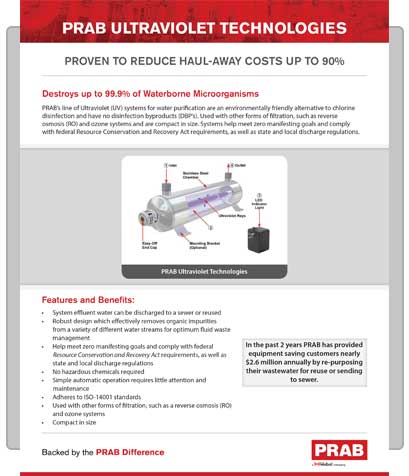PRAB Ultraviolet Technologies

Download PDF
Proven to Reduce Haul-Away Costs Up to 90%Destroys up to 99.9% of Waterborne MicroorganismsPRAB’s line of Ultraviolet (UV) systems for
water purification are an
environmentally friendly alternative to chlorine disinfection and have no disinfection byproducts (DBP’s). Used with other forms of
filtration, such as
reverse osmosis (RO) and
ozone systems are compact in size. Systems help meet zero manifesting goals and comply with federal Resource Conservation and Recovery Act requirements, as well as state and local discharge regulations.
Features and Benefits:
- System effluent water can be discharged to a sewer or reused
- Robust design which effectively removes organic impurities from a variety of different water streams for optimum fluid waste management
- Help meet zero manifesting goals and comply with federal
- Resource Conservation and Recovery Act requirements, as well as state and local discharge regulations
- No hazardous chemicals required
- Simple automatic operation requires little attention and maintenance
- Adheres to ISO-14001 standards
- Used with other forms of filtration, such as a reverse osmosis (RO) and ozone systems
- Compact in size
In the past 2 years PRAB has provided equipment saving customers nearly $2.6 million annually by re-purposing their wastewater for reuse or sending to sewer.
Backed by the PRAB Difference
Destroy Up to 99.9% of Waterborne MicroorganismsOur UV systems effectively destroy 99.9% of waterborne microorganisms. Effluent water can be discharged to a sewer or reused. Systems offer a robust design which effectively removes impurities from a variety of different water streams for optimum fluid waste management.
Options:
Ultraviolet can also be used for Total Oxidizable Carbon (TOC). These systems typically utilize thin cylindrical bulbs capable of generating UV light in the 185 nm range, placed in close physical proximity to high-purity glass tubes through which the water flows. UV light possesses considerable energy and is absorbed by compounds and organisms at most wavelengths. However, certain wavelengths are more effective due to energy and absorption characteristics so as to induce maximum effect. For example, bacteria are most susceptible at 254 nanometers (nm). At a wavelength of 185 nm, the increased energy and adsorption sensitivity of oxidizable organic compounds leads to formation of hydroxyl free radicals in varying degrees of photochemical excitement. These hydroxyl (OH-) free radicals break various chemical bonds of organics, which in turn produce chain reactions, oxidizing most organics into carbon dioxide and water, the basic building blocks of all organic compounds.
Applications:
- Machining and Grinding: Water-soluble, semi-synthetic and synthetic coolants
- Washwaters: Alkaline and acidic
- Stamping: Heavily fortified stamping fluids and washwater
- Transportation: Oily water vehicle discharge
- Vibratory Deburring: Oil and solid laden deburring liquids
- Pressure Wash: Oily water discharge
- Surface Finishing
- Die Casting
Contact us to request a quote today


